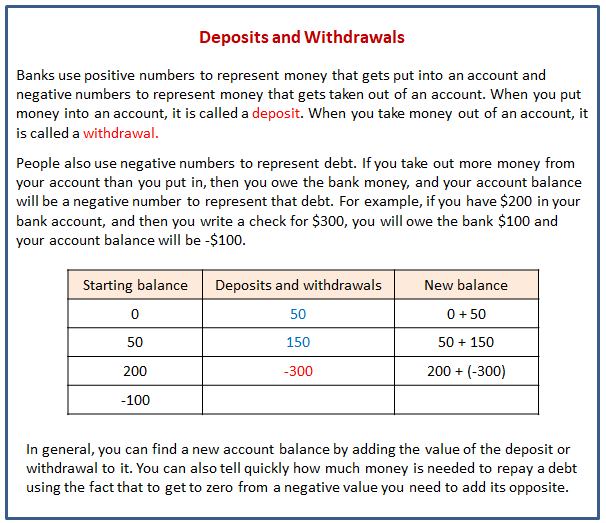Illustrative Mathematics Grade 7, Unit 5, Lesson 4: Money and Debts
Learning Targets:
- I understand what positive and negative numbers mean in a situation involving money.
Related Pages
Illustrative Math
Grade 7
Lesson 4: Money and Debts
Let’s apply what we know about signed numbers to money.
Illustrative Math Unit 7.5, Lesson 4 (printable worksheets)
Lesson 4 Summary
The following diagram shows what positive and negative numbers mean in a situation involving money: deposits and withdrawals.

Lesson 4.1 Concert Tickets
Priya wants to buy three tickets for a concert. She has earned $135 and each ticket costs $50. She borrows the rest of the money she needs from a bank and buys the tickets.
- How can you represent the amount of money that Priya has after buying the tickets?
- How much more money will Priya need to earn to pay back the money she borrowed from the bank?
- How much money will she have after she pays back the money she borrowed from the bank?
Lesson 4.2 Cafeteria Food Debt
At the beginning of the month Kiran had $24 in his school cafeteria account. Use a variable to represent the unknown quantity in each transaction below and write an equation to represent it. Then, represent each transaction on a number line. What is the unknown quantity in each case?
- In the first week he spent $16 on lunches. How much was in his account then?
- Then he deposited some more money and his account balance was $28. How much did he deposit?
- Then he spent $34 on lunches the next week. How much was in his account then?
- Then he deposited enough money to pay off his debt to the cafeteria. How much did he deposit?
- Explain why it makes sense to use a negative number to represent Kiran’s account balance when he owes money.
Lesson 4.3 Bank Statement
Here is a bank statement.
- If we put withdrawals and deposits in the same column, how can they be represented?
- Andre withdraws $40 to buy a music player. What is his new balance?
- If Andre deposits $100 in this account, will he still be in debt? How do you know?
Are you ready for more?
The national debt of a country is the total amount of money the government of that country owes. Imagine everyone in the United States was asked to help pay off the national debt. How much would each person have to pay?
Lesson 4 Practice Problems
- Decide whether or not each equation represents a proportional relationship.
a. Volume measured in cups (c) vs. the same volume measured in ounces (z): c = 1/8 z
b. Area of a square (A) vs. the side length of the square (s): A = s2
c. Perimeter of an equilateral triangle (P) vs. the side length of the triangle (s): 3s = P
d. Length (L) vs. width (w) for a rectangle whose area is 60 square units: L = 60/w - a. Clare has $54 in her bank account. A store credits her account with a $10 refund. How much does she now have in the bank?
b. Mai owes the bank $60. She gets $85 for her birthday and deposits it into her account. How much does she now have in the bank?
c. Tyler is overdrawn at the bank by $180. His brother has $70 more than him. How much money does Tyler’s brother have?
d. Andre has $37 in his bank account and writes a check for $87. After the check has been cashed, what will the bank balance show? - Last week, it rained g inches. This week, the amount of rain decreased by 5%. Which expressions represent the amount of rain that fell this week? Select all that apply.
- The table shows five transactions and the resulting account balance in a bank account, except some numbers are missing. Fill in the missing numbers.
- Add.
- In each diagram, x represents a different value. For each diagram,
a. What is something that is definitely true about the value of x?
b. What is something that could be true about the value of x?
The Open Up Resources math curriculum is free to download from the Open Up Resources website and is also available from Illustrative Mathematics.
Try out our new and fun Fraction Concoction Game.
Add and subtract fractions to make exciting fraction concoctions following a recipe. There are four levels of difficulty: Easy, medium, hard and insane. Practice the basics of fraction addition and subtraction or challenge yourself with the insane level.

We welcome your feedback, comments and questions about this site or page. Please submit your feedback or enquiries via our Feedback page.